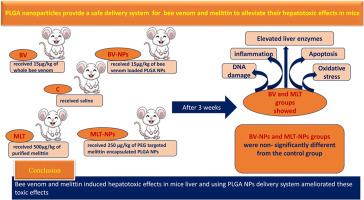PLGA纳米颗粒为蜂毒和蜂毒素提供了一种安全的递送系统,以减轻其对小鼠的肝毒性作用。
IF 2.4
4区 医学
Q2 PHARMACOLOGY & PHARMACY
引用次数: 0
摘要
蜂毒及其主要肽蜂毒素是具有多种治疗作用的天然化合物。它们也因其溶血和细胞毒性而闻名,这使它们在医学上得到了应用。聚乳酸-羟基乙酸(PLGA)是一种广泛应用于不同药物递送的聚合物。本文研究了蜂毒和蜂毒素对小鼠肝脏的毒性作用。此外,研究了通过PLGA纳米颗粒递送蜂毒和蜂毒素对降低其毒性作用的影响。将50只雄性小鼠随机分为5组,腹腔注射3周:对照组(生理盐水)、蜂毒(15μg/kg)、蜂毒素(500μg/kg)、蜂毒负载PLGA NPs (15μg/kg)、PEG靶向蜂毒素包封PLGA-NPs (250 μg/kg)。通过肝功能测试(丙氨酸转氨酶、碱性磷酸酶)检测肝毒性作用,并测定氧化应激(总抗氧化能力、丙二醛)。细胞凋亡(DNA片段化试验,caspase3),炎症(il - 1β)和组织病理学分析。结果表明,蜂毒和蜂毒对肝脏有一定的毒性作用,其表现为肝酶和氧化应激标志物的增加,以及两种物质引起的炎症和细胞凋亡。另一方面,使用PLGA递送系统改善了大多数这些毒性作用。目前的研究证明,蜂毒和蜂毒素会引起肝毒性作用,使用PLGA给药系统可以减少大部分这些毒性作用,从而使蜂毒素和蜂毒在未来的使用更加安全。本文章由计算机程序翻译,如有差异,请以英文原文为准。

PLGA nanoparticles provide a safe delivery system for bee venom and melittin to alleviate their hepatotoxic effects in mice
Bee venom and its principal peptide, melittin, are natural compounds with many therapeutic effects. They are also known for their hemolytic and cytotoxic properties that render their medical applications. Poly lactic-co-glycolic acid (PLGA) is a popular polymer used for different drug delivery. The present study investigated the toxic effect of bee venom and melittin on the liver of mice. Furthermore, the impact of delivering bee venom and melittin via PLGA nanoparticles on reducing their toxic effects was investigated. Fifty male mice were divided randomly into five equal groups and were injected intra-peritoneally for 3 weeks as follows: control (saline), bee venom (15 μg/kg), melittin (500 μg/kg), bee venom loaded PLGA NPs (15 μg/kg), PEG targeted melittin-encapsulated PLGA-NPs (250 μg/kg). The hepatotoxic effect was examined through liver function tests (alanine aminotransferase, alkaline phosphatase), and oxidative stress was determined (total antioxidant capacity, malondialdehyde). Additionally, apoptosis (DNA fragmentation test, caspase3), inflammation (IL1β) and histopathological analysis were measured. The results revealed that melittin and bee venom have toxic effects on the liver, which were evidenced by increased liver enzymes and oxidative stress markers, in addition to inflammation and apoptosis caused by both substances. On the other hand, using the PLGA delivery system ameliorated most of these toxic effects. The present study proved that bee venom and melittin cause hepatotoxic effects and using the PLGA delivery system reduced most of these toxic effects enabling safer usage of melittin and bee venom in the future.
求助全文
通过发布文献求助,成功后即可免费获取论文全文。
去求助
来源期刊

Toxicon
医学-毒理学
CiteScore
4.80
自引率
10.70%
发文量
358
审稿时长
68 days
期刊介绍:
Toxicon has an open access mirror Toxicon: X, sharing the same aims and scope, editorial team, submission system and rigorous peer review. An introductory offer Toxicon: X - full waiver of the Open Access fee.
Toxicon''s "aims and scope" are to publish:
-articles containing the results of original research on problems related to toxins derived from animals, plants and microorganisms
-papers on novel findings related to the chemical, pharmacological, toxicological, and immunological properties of natural toxins
-molecular biological studies of toxins and other genes from poisonous and venomous organisms that advance understanding of the role or function of toxins
-clinical observations on poisoning and envenoming where a new therapeutic principle has been proposed or a decidedly superior clinical result has been obtained.
-material on the use of toxins as tools in studying biological processes and material on subjects related to venom and antivenom problems.
-articles on the translational application of toxins, for example as drugs and insecticides
-epidemiological studies on envenoming or poisoning, so long as they highlight a previously unrecognised medical problem or provide insight into the prevention or medical treatment of envenoming or poisoning. Retrospective surveys of hospital records, especially those lacking species identification, will not be considered for publication. Properly designed prospective community-based surveys are strongly encouraged.
-articles describing well-known activities of venoms, such as antibacterial, anticancer, and analgesic activities of arachnid venoms, without any attempt to define the mechanism of action or purify the active component, will not be considered for publication in Toxicon.
-review articles on problems related to toxinology.
To encourage the exchange of ideas, sections of the journal may be devoted to Short Communications, Letters to the Editor and activities of the affiliated societies.
 求助内容:
求助内容: 应助结果提醒方式:
应助结果提醒方式:


